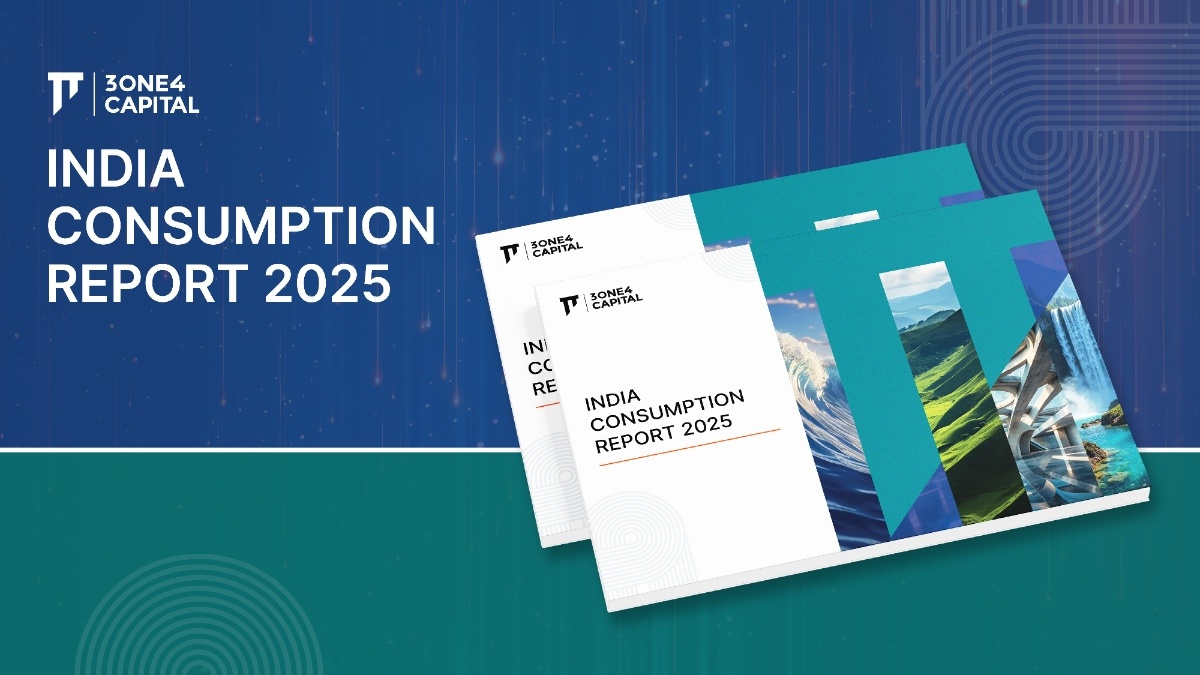
Beyond the Hype: Why India's Market Shift is Real
1. India’s Household Savings Enter a Generational Shift to Equities
India’s equity story runs deeper than market caps and monthly inflows. We’re witnessing the mass financialisation of household savings as more Indian families channel their wealth from traditional assets into equities and mutual funds. This shift is highlighted in the changing composition of household financial assets from 2014 to 2024, marking a move from savings and fixed assets to investments and liquid assets.
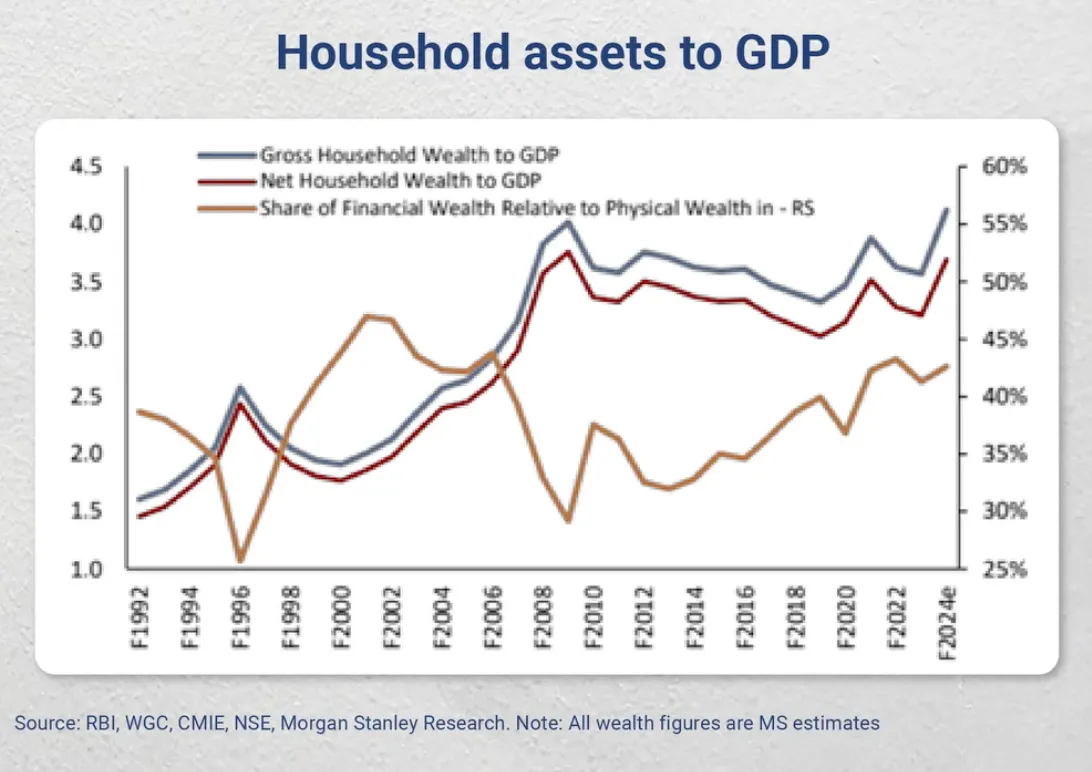
Over the past decade, the share of household financial assets in equities and mutual funds has almost doubled, marking a generational shift in investment mindsets. Bank deposits have moved from 53% to 42% of household wealth between 2020 and 2024. The growing preference for equities and mutual funds is clear, and both saw an increase from 10% and 9% in 2020 to 12% each by 2024.
Picture a young professional couple in Bangalore who, instead of stashing their savings in fixed deposits, now routinely invest in index funds or even dabble in individual stocks. Multiply that scenario by millions, and the implications become profound.
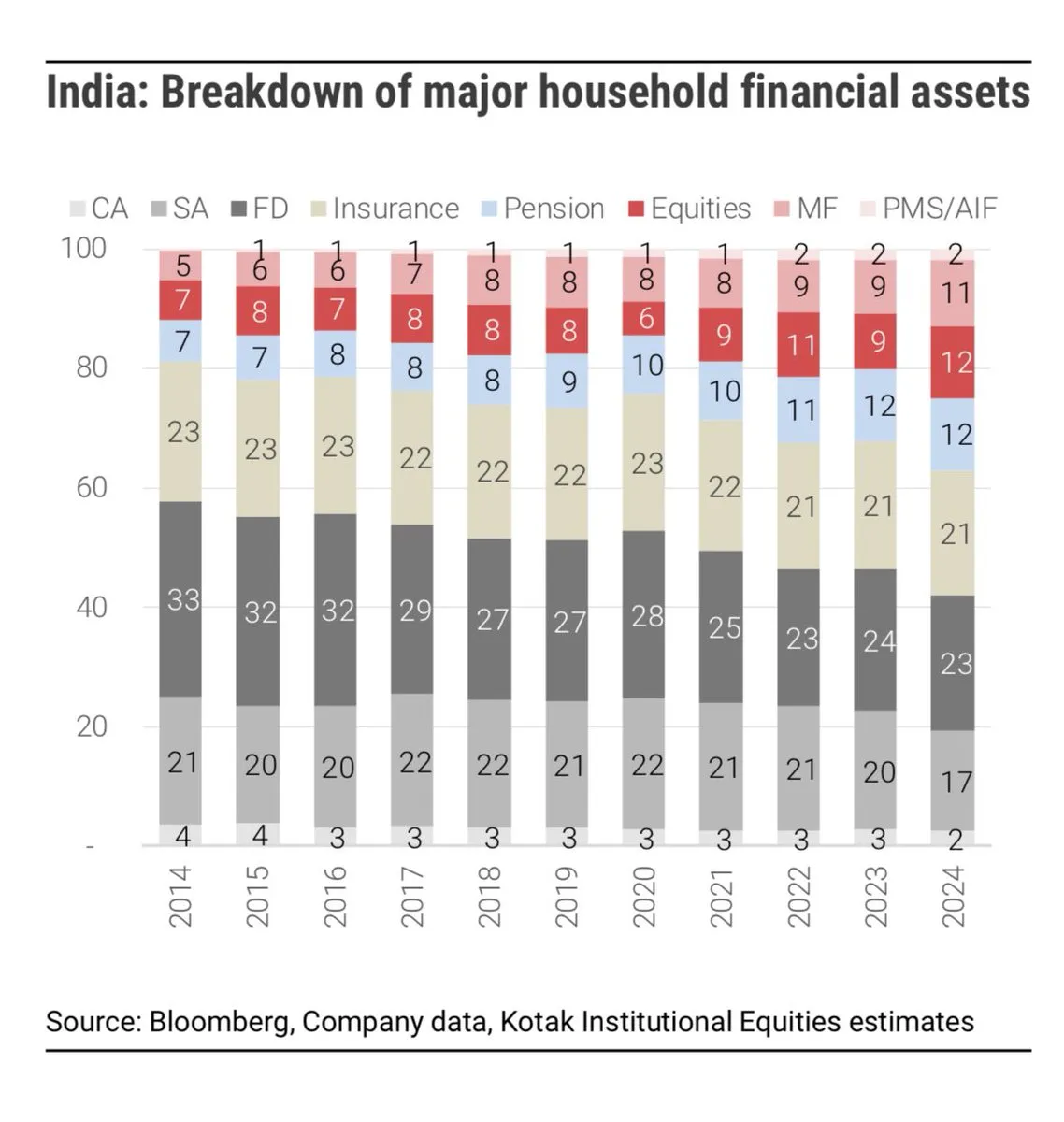
This recalibration of capital allocation will ripple through every layer of the economy. Taxation frameworks, RBI policy considerations, and even election narratives may shift as domestic investors gain a stronger voice and larger stake. In short, India’s rise to the world’s fourth-largest equity market is more than a statistic. It is a sign of deep, structural transformations reshaping the country’s economic DNA, an orbital shift in the aspirations of the new generation, and the setting of the stage for sustainable, broad-based equity market growth.
2. India has been the Best-Performing Emerging Market for Equities, Better than China
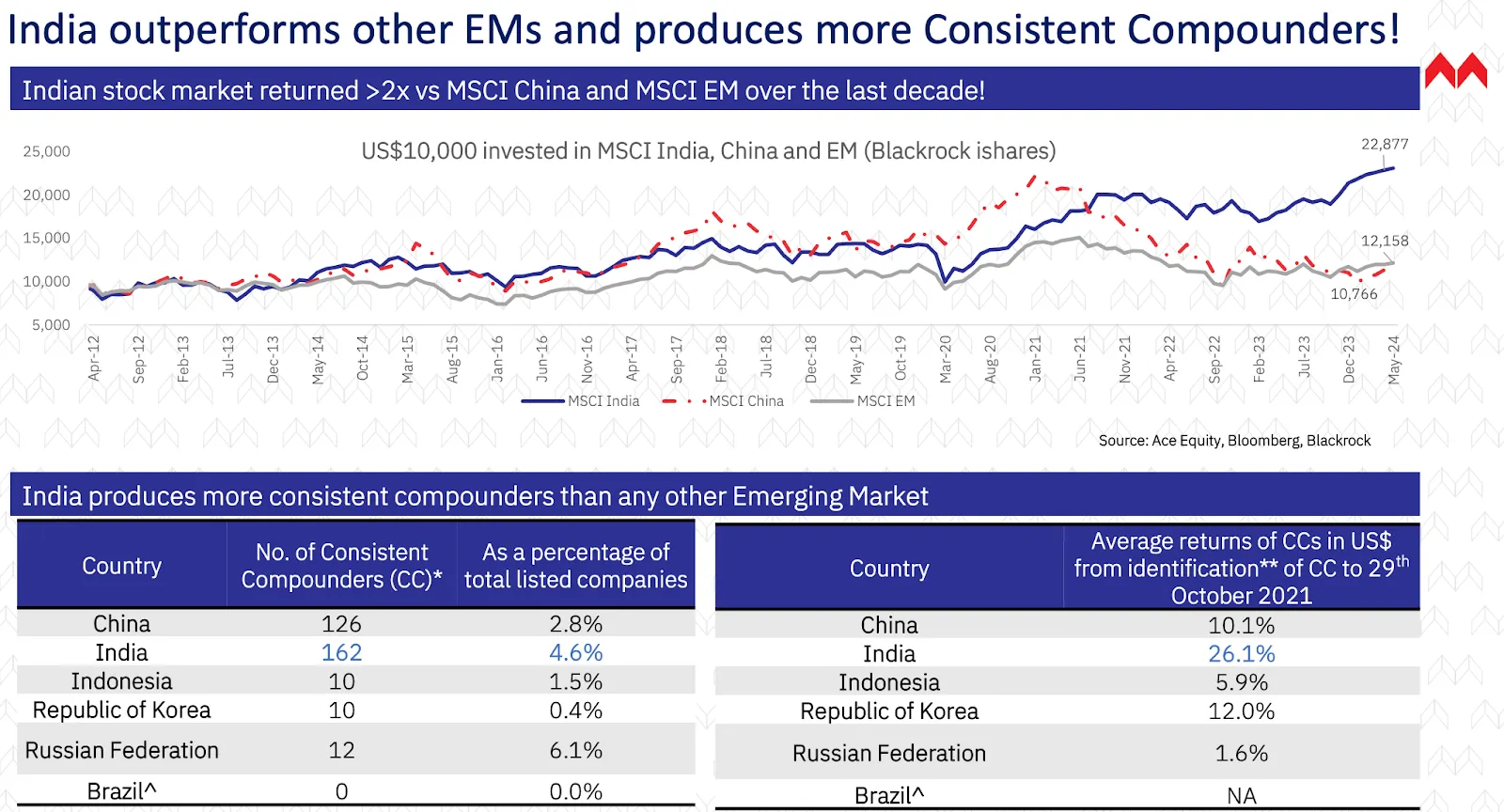
Over the last decade, India has quietly yet steadily outshined its emerging market peers, including China, when it comes to equity market performance. Data comparing $10,000 invested across the MSCI India, MSCI China, and broader MSCI Emerging Markets indices highlight a striking divergence: India’s trajectory looks like a well-paced marathoner who not only finishes first but does so with a consistently paced stride.
What’s driving India’s lead in this global race? The answer extends beyond the headline indices. The country has cultivated a uniquely fertile environment for what our friends at Marcellus call “Consistent Compounders”—companies that reliably grow earnings and generate solid, compounding returns year after year. For instance, India boasts a higher proportion of these persistent outperformers than China or other EMs. This signal is more than just a statistic; it indicates strong corporate governance, better capital allocation, and a willingness among Indian businesses to invest in sustainable growth for the long haul. This has built a culture of trust around India’s large and mid-cap leaders, inviting global investors to achieve stellar returns over multiple decades.
Imagine a mid-cap manufacturing firm in Gujarat, steadily scaling its product lines and strengthening its distribution channels over the past decade. Instead of chasing fads, it invests in its R&D, supply chain optimisation, governance processes, and sustainable practices. After a few years, such deliberate efforts translate into consistent profit growth, making it a hidden gem that long-term investors continue to hold. Multiply that example by dozens of similar companies across industries—consumer goods, financial services, manufacturing, software exports—and you start to see why the Indian equity basket consistently beats the broader EM basket.
This performance has not materialised overnight. It is the cumulative effect of market reforms, strict regulations, a surge in domestic liquidity (thanks to the rise of mutual funds and retail participation), and a corporate culture increasingly attuned to global best practices. In many ways, India’s success story in equities reflects a blend of robust top-down policies and grassroots entrepreneurial vigour. Companies are maturing into “value creators” rather than just growth-at-any-cost ventures.
Looking ahead, this outperformance sets a powerful precedent. As a wave of Indian startups matures into public-market contenders, investors can anticipate an even more diverse set of winners rising to the fore. If India can continue to nurture this environment—supporting innovation, encouraging transparency, and maintaining stable policy backdrops—its “Consistent Compounders” will remain the cornerstone of its market narrative. The result? A sustained, long-term advantage that continues to put India ahead of the emerging market curve.
3. Indian corporate earnings are far outpacing China's
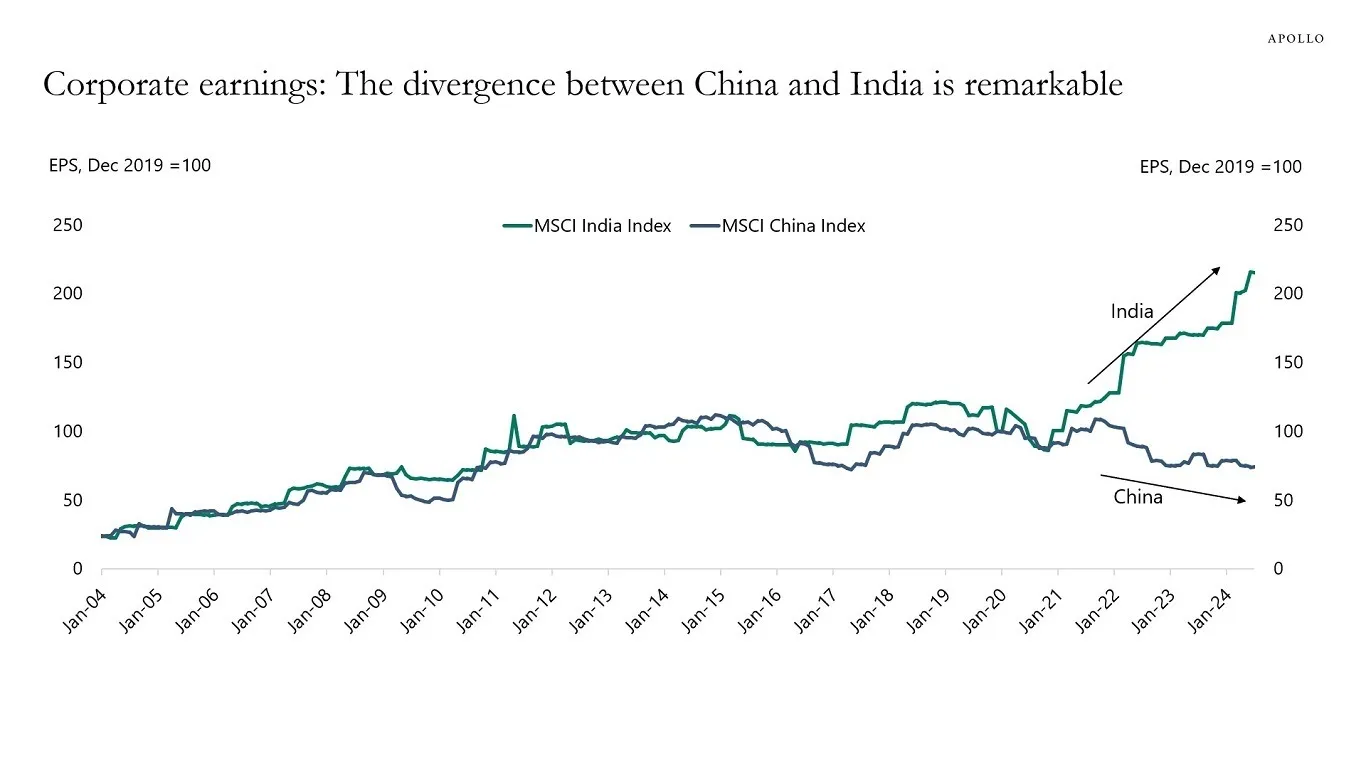
Over the past few years, India’s corporate earnings have taken a striking lead over their Chinese counterparts—a divergence that grows more pronounced with each passing quarter. Consider this: while China’s earnings have struggled to regain momentum, Indian companies are charting a steady upward path. What’s behind this shift? It’s not just a matter of luck or fleeting market sentiment; it’s about deep structural changes, stable policy frameworks, and a focused commitment to long-term corporate value creation.
Let’s picture this in human terms. Think about a mid-sized automotive components manufacturer in Pune. A decade ago, this company might have been churning out standard parts, competing largely on cost as state-subsidised Chinese competitors dump their excess output routinely. Today, it invests in R&D, uses advanced robotics, and builds long-term trust-oriented relationships with global OEMs to co-develop next-gen electric vehicle components. Rather than chasing short-term wins based on IP infringement and price exploitation, it is building competitive advantages and strengthening its supply chain, ultimately boosting earnings year after year.
India’s economic and regulatory environment has learned to nurture this kind of business evolution. Corporate governance reforms, infrastructure investments, and a more predictable policy climate have allowed companies to grow earnings consistently. The result? A deeper bench of reliable earners—firms that can weather macro headwinds and still deliver profits that impress both domestic and global investors.
From a venture capital perspective, these data points are more than just lines on a chart. Strong corporate earnings growth expands our pipeline of proven markets that that can support younger companies to scale sustainably, attract global partnerships, and eventually become market leaders. Investors gain the confidence to deploy capital more aggressively, knowing the ecosystem supports long-term success rather than short-term flips.
Meanwhile, this trend has ripple effects that run through India’s entire economic fabric. As established corporations thrive, they create demand for innovative suppliers, startups that innovate on novel IP, and service providers—fueling a broader cycle of entrepreneurship and economic evolution. That’s what makes this divergence in corporate earnings not just a one-off story, but a structural narrative. India’s corporate sector isn’t just catching up; it’s leading the EM pack and reshaping the narrative for what is possible in this country.
4. India Inc. Records Highest Profitability at 13.5% of India’s GDP
Let’s take a moment to unpack a remarkable data point: India Inc.’s pre-tax profits in FY 2023-24 reached an estimated INR 45.28 lakh crore—equivalent to around 13.5% of India’s GDP as of March 2024. Just to put this into perspective, corporate tax collections alone hit INR 11.32 lakh crore, growing over 13% from the previous year’s INR 10 lakh crore. When you consider the corporate tax rate at about 25%, it’s clear India’s corporate ecosystem is operating at a whole new level of profitability.
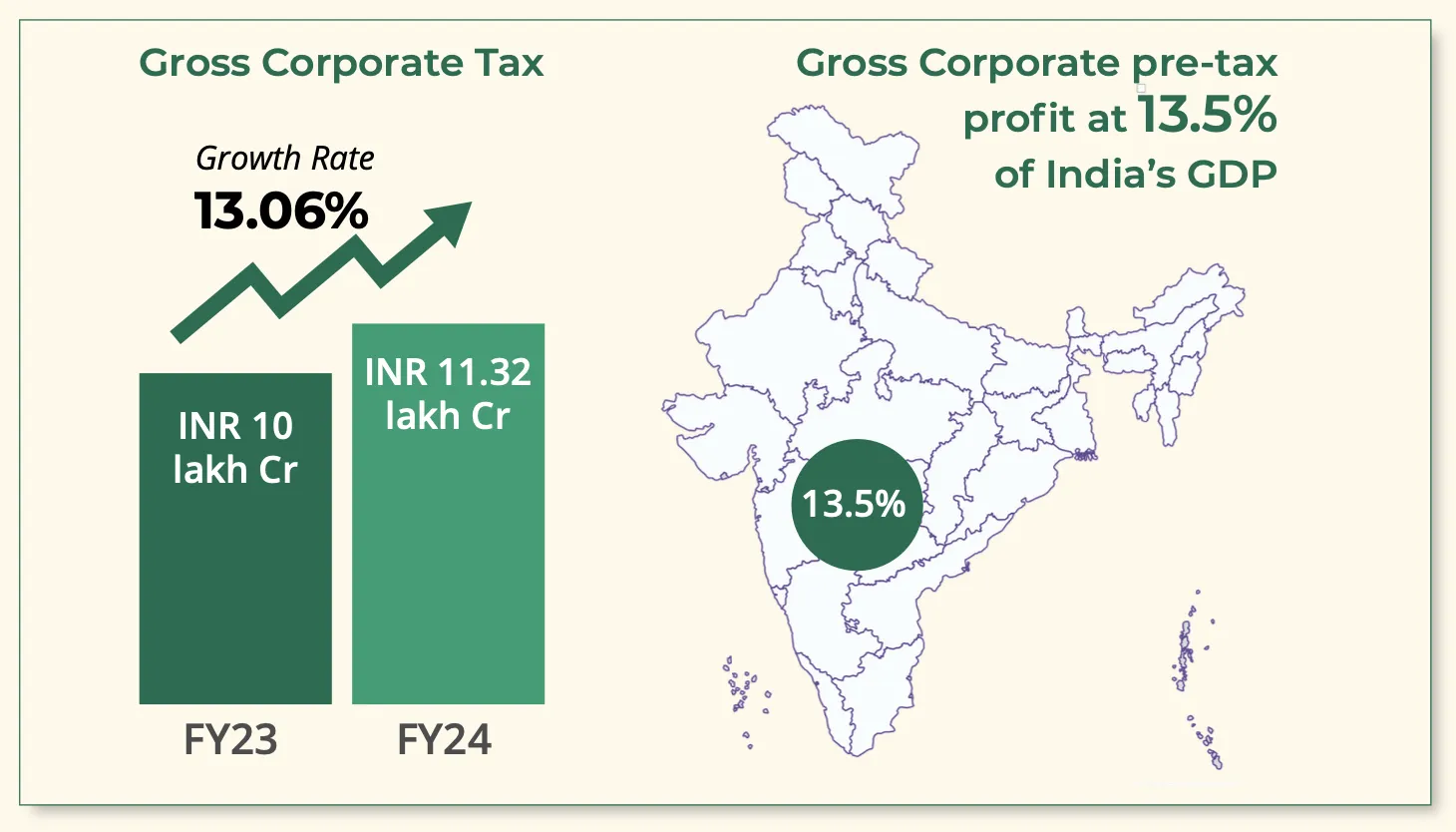
Why does this matter? For one, it’s the kind of underlying strength that accelerates a new capital expenditure (capex) cycle, reminiscent of the early-2000s investment boom. As companies pay down debt using their own free cash flows—rather than relying heavily on new bank borrowings—they’re freeing up room to invest in new projects, upgrade their capabilities, and scale up operations. Picture a mid-sized manufacturing firm in Chennai that has just paid off a big chunk of its loans and is now using that liquidity to upgrade its assembly lines with automation and robotics. This shift improves margins and nudges the entire supply chain toward higher productivity and quality.
Across sectors, balance sheets are getting leaner and stronger. Public markets are rewarding firms that demonstrate capital allocation discipline and strategic expansion. When investors see consistent earnings growth and smart allocation decisions—like companies prioritising infrastructure upgrades, investing in R&D, or expanding their distribution networks—they respond by rerating these stocks. The result is a virtuous cycle: strong profits lead to confident spending, which fuels growth, which in turn reinforces market confidence.
The bigger picture, as highlighted by Morgan Stanley, is that India’s investment-to-GDP ratio could hit 36% by 2027, propelled first by public investments and, increasingly, by private sector participation. In fact, the public investment push—think infrastructure projects like highways, renewable energy grids, and logistics hubs—is laying the groundwork for private players to step in with their own expansions. This combination of public-led foundation building and private-led scaling is key to achieving a more sustained capex cycle than in the 2003-07 era.
If all goes well, India may even tilt towards investment ratios approaching 40% of GDP. That kind of long-term investment momentum—underpinned by robust corporate profitability—has ripple effects across the economy. It can drive deeper innovation, improve productivity, acquire younger businesses, and raise wages and living standards. From a venture capital perspective, it translates into a more fertile landscape where startups can thrive, scale, and potentially emerge as the acquisition targets of today’s market leaders.
In short, India Inc.’s record-setting profitability isn’t just an accounting phenomenon. It is a structural shift reshaping capital allocation patterns, influencing public policy, and encouraging both domestic and international investors to lean in. This “tidal force” beneath the surface is powering a new growth narrative that’s increasingly driven by long-term thinking, sustainable capital flows, and strategic deployment of surpluses.
5. India is now the Fourth-Largest Equity Market in the World
India’s equity landscape has radically transformed over the last few years, culminating in a landmark milestone earlier this year. In January 2024—just 54 days after surpassing the $4 trillion mark—India’s stock market officially overtook Hong Kong’s, making it the fourth-largest equity market. By October 2024, India’s total market capitalisation stood at $4.9 trillion, placing it behind the U.S., China, and Japan. This quick climb follows overtaking France and the UK in mid-2023, underscoring that India’s ascent isn’t a fleeting blip—it’s a consistent upward march.
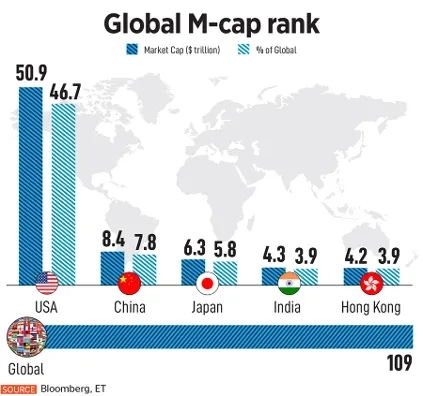
Source: Bloomberg, ET
What’s driving this long-term momentum? A key factor is the dependable stream of domestic capital flowing into the markets. Roughly $4 billion in local liquidity from SIPs (Systematic Investment Plans), pension funds, and institutional contributors enters the market each month, providing a steady foundation that’s grown less reliant on foreign inflows. Even in periods when foreign institutional investors trimmed their positions, Indian equities have maintained their footing—most quarters have even outperformed the top three markets.
6. India will be a +$20 Trillion GDP Economy by 2050
India’s economic strides over the last 4 years are nothing short of remarkable. At the close of FY23, nominal GDP stood at $3.4 trillion (₹273 lakh crore), making India the world’s fifth-largest economy. Even more striking is the pace: FY23 saw nominal GDP growth of around 16%, following an 18.4% surge in FY22. This performance outpaced even the rosiest forecasts, especially during a period when many large economies were stalled post-pandemic.
Projecting forward, if India maintains a steady growth trajectory, it could reach $4 trillion (₹338 lakh crore) over CY25. Given current momentum, India could realistically hit $5 trillion by CY28 if forex holds steady, firmly securing its position as the world’s third-largest economy.
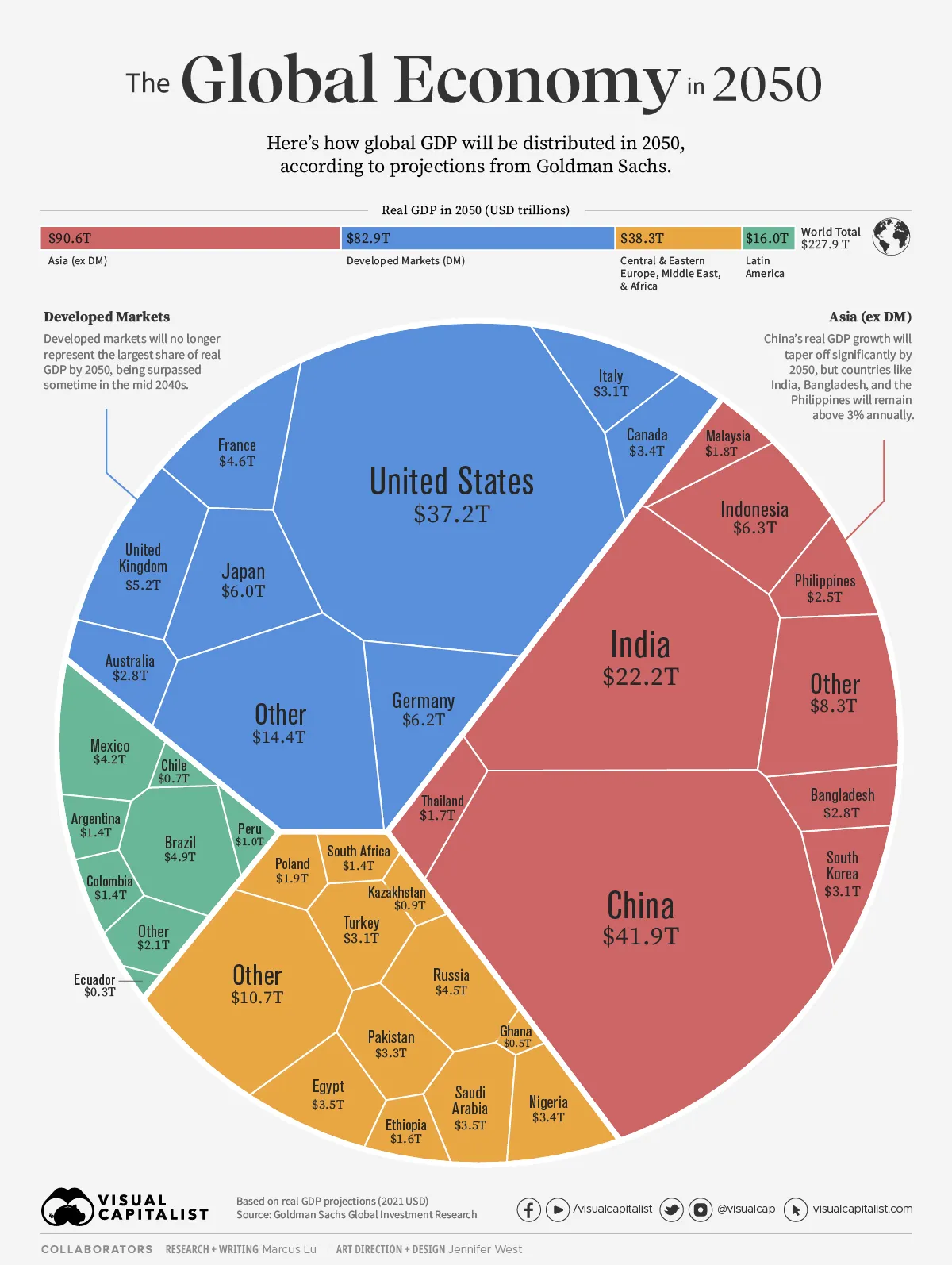
According to long-term analyses, including those highlighted by Goldman Sachs’ projections, India is set up to surge past $5 trillion. By 2050, India’s GDP could surpass $20 trillion, joining the U.S. and China as the only economies in the double-digit trillion-dollar league. In fact, the data suggests India will remain above a 5.5% annual growth rate, steadily catching up to established giants and leapfrogging many advanced economies by mid-century.
Unlike previous cycles where external shocks hit emerging markets harder, India has shown resilience through multiple global crises—the pandemic, the 2008 financial crash, the early-2000s tech bubble, and the 1997 Asian crisis. Even the pandemic-induced downturn was mild compared to historical standards, with a quick rebound in FY22.
This robust growth is a multi-layered story. We’re seeing:
- Strong Domestic Demand: A huge internal market that can absorb global shocks better than more export-reliant maturing economies.
- Rapid Formalization: From GST to UPI-based digital payments, reforms have brought more businesses into the formal economy, improving tax collection and data-driven policymaking.
- Capex Expansion: Both public and private sectors are ramping up infrastructure and manufacturing investments, reducing dependency on external capital.
- Local Manufacturing Boom: Initiatives like “Make in India” and PLI (Production-Linked Incentives) schemes are supporting a thriving manufacturing base.
- Energy Transition: Sustainable investments and a push into renewable energy reduce long-term vulnerability to global commodity shocks.
As India’s economy scales towards $5 trillion soon and sets its sights on $20 trillion by 2050, we’re not just witnessing a linear growth story but a structural evolution. This transformation is powered by policy reforms, steady capital formation, digital infrastructure, and a young, ambitious workforce. For investors, entrepreneurs, and policy thinkers, India’s journey signals immense opportunities across sectors—from climate tech and manufacturing automation to frontier tech and beyond.
7. India’s Remarkable Leap in the Global Innovation Index 2024
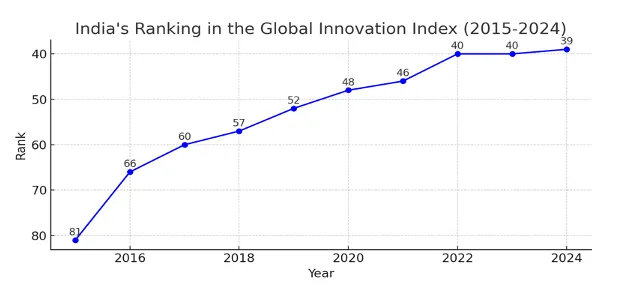
India’s stride in the Global Innovation Index (GII) 2024 tells the story of a nation that’s making innovation part of its very DNA. In a field of 133 economies, India now ranks 39th—a remarkable rise from its 81st position in 2015. This journey is far from accidental. It reflects a policy environment that steadily shifted from incremental reform to strategic overhaul, boosting R&D investments, streamlining regulatory processes, and incentivising intellectual property generation and protection. What we’re seeing today is the outcome of a decade’s concerted efforts to fuel a culture where both cutting-edge startups and established industries experiment, collaborate, and scale.
Over the past few years, government initiatives like “Startup India” and a relentless push towards digital infrastructure have cleared paths that once seemed swamped by red tape. This environment has lifted India’s GDP while transforming its innovation profile. From deep-tech accelerators in Bengaluru to biotech hubs in Hyderabad, the emphasis on science, technology, and entrepreneurial acumen is reshaping the country’s global brand.
This isn’t merely a numerical feat; it’s an indicator that India is fast maturing from a service-driven economy to one that thrives on intellectual capital. Prime Minister Narendra Modi called the advancement a “remarkable feat,” underlining the government’s commitment to an ecosystem where innovation isn’t a buzzword—it’s a baseline expectation. These policies are helping unlock the potential of India’s young professionals, whose energy and creativity are now directed towards solving complex challenges, from fintech inclusion to industrial automation.
India leads the pack in Central and Southern Asia, stands as a leader among lower-middle-income countries, and ranks 4th worldwide in WIPO’s Science & Technology Cluster Ranking. Cities like Mumbai, Delhi, Bengaluru, and Chennai are now recognised as top 100 global innovation clusters. This urban innovation fabric weaves together academic research institutions, venture capital firms, corporate R&D centres, and a consistent supply of STEM talent—all the ingredients that top consulting frameworks identify as catalysts for sustained competitive advantage.
Moreover, India’s seventh-place ranking in intangible asset intensity and its leap to 33rd in innovation outputs reinforce the narrative: the country is no longer content to be a back-office for global giants. Instead, it is becoming the launchpad for next-generation solutions, whether in AI-driven agritech platforms, climate-resilient energy systems, or breakthrough medical diagnostics.
For venture investors, policymakers, and entrepreneurs, India’s GII ascent is a crucial data point that signals confidence and conviction. Higher innovation rankings often correlate with stronger IP frameworks, more efficient market expansion, and a more vibrant ecosystem where risk-taking is rewarded. This environment provides fertile ground for early-stage investments, scale-ups, and even large global players looking to anchor R&D in Asia’s fastest-growing hub.
India’s forward momentum, backed by stable governance, targeted reforms, and a surge in digital adoption, positions it to harness emerging technologies and shape global value chains. The country’s innovation narrative isn’t just about hitting a rank but building a more resilient, tech-driven economy. As India approaches a critical threshold—where innovation becomes self-sustaining and deeply ingrained in its economic fabric—the coming years will test and validate these gains. Yet, given its track record, India looks set to maintain its leadership in innovation and push the global frontier, inspiring other emerging markets along the way.


.webp)
